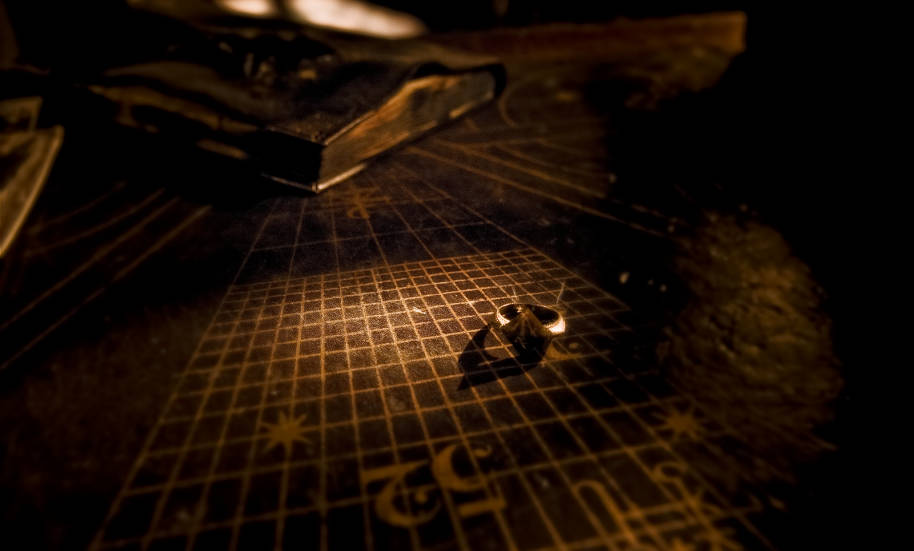In Deathly Hallows, Harry, Ron and Hermione were older and wiser than those three innocent kids we first met in Philosopher’s Stone. However, echoes from their first-ever adventure surface again as they go on the quest to destroy Voldemort’s Horcruxes.
It got us thinking: have you ever noticed how Harry’s story at Hogwarts seemed to come around full circle?
Harry had owned one of the Hallows since the first book
When Harry learnt of the old Beedle the Bard story ‘The Tale of the Three Brothers’, he became obsessed with the Deathly Hallows – three objects that supposedly made the person who possessed them ‘master of Death’. Harry became convinced that owning all three would help him defeat Voldemort.
But Harry actually owned one of the Hallows all along – his father’s Invisibility Cloak was passed down to him in his very first year at Hogwarts. In the story, it was this item that the third brother used to evade Death for many years. Which is rather funny, considering Harry mostly used it to sneak around school after hours, evading Filch and playing the odd prank on Malfoy.
Neville’s bravery came full circle
As Dumbledore said in Philosopher’s Stone: ‘It takes a great deal of bravery to stand up to our enemies, but just as much to stand up to our friends.’ This became sound advice for the initially timid Neville Longbottom, who lived up to Dumbledore’s words of praise more than once.
In his first year, Neville put aside his nerves to stand up to Harry, Ron and Hermione, who were sneaking about after hours – actually to protect the Philosopher’s Stone, but he wasn’t to know that. Neville ended up winning the House Cup for Gryffindor for his troubles.
Skip forward to his seventh year, and Neville led Dumbledore’s Army with Luna and Ginny, bravely standing up to the Carrows and even to Lord Voldemort himself at the Battle of Hogwarts. He also destroyed a Horcrux, Nagini the snake.
Neville’s transformation from the first book to the last was truly incredible – but that moment of bravery from his first year showed he had that fire in him all along.
Both books feature two, life-changing stones
The first and last book are punctuated by two magical stones, both of which could magically change lives in two very different ways. In Harry’s first year, Voldemort was intent on obtaining the Philosopher’s Stone, a creation by Nicolas Flamel that could extend one’s life.
In Harry’s last year, he obtained the Resurrection Stone – an object that could summon people from the dead, albeit not fully.
Death was a huge theme in the Harry Potter stories, particularly Lord Voldemort’s obsession with trying to evade it. On both occasions, Voldemort failed to possess them and both stones were cast aside. As Dumbledore said when he explained why the Philosopher’s Stone was to be destroyed: ‘Humans do have a knack of choosing precisely those things which are worst for them.’

The Put-Outer and The Deluminator seem very, very similar
One of the first magical objects we encountered in Philosopher’s Stone (or indeed any of the Harry Potter books) was Albus Dumbledore’s ‘Put-Outer’; a nifty little device that could extinguish lights. In Deathly Hallows, Ron was bequeathed a very similar (or was it the same?) item in Dumbledore’s will, called a Deluminator. Working in a very similar way, the Deluminator was apparently Dumbledore’s ‘own design’ and Ron initially spent the majority of his time with it turning on and off lights, much to Hermione’s annoyance.
It wasn’t until Ron left Harry’s hunting-Horcrux quest that the Deluminator turned out to be a little more sophisticated. Casting a light that went right inside Ron’s chest, Ron was able to find his way back to Harry and Hermione thanks to the Deluminator’s mysterious actions. It suddenly became more clear why Dumbledore bequeathed such an item to Ron, to help him if he ever got lost.
The first Snitch Harry caught returned in a vital way
Harry was bequeathed a gift from Dumbledore too: the first Snitch he ever caught as Gryffindor’s Seeker. Well, ‘swallowed’ rather than caught, really. It was engraved with the words ‘I open at the close’, which mystified Harry throughout most of the book, and only sprang to life right at the very end.
It turned out that the Snitch actually contained another of the Deathly Hallows: the Resurrection Stone. We also learnt that Snitches contained ‘flesh memory’, meaning they only react to the person who first touched them. But even without containing one of the most powerful magical objects in history inside it, bringing back Harry’s first-ever Snitch was a truly sentimental moment on its own, and very bittersweet that one of his first magical moments was with Harry at the very end.
King’s Cross station was hugely significant
Although Muggle commuters may not see King’s Cross Station as particularly sentimental (especially on a Monday morning) the station had colossal value to Harry, and returned to him in Deathly Hallows in the most surreal way. Platform nine and three-quarters was, after all, a gateway between the normal world and the wizarding world, and it was here that Harry ended up when he was nearing the end of his life – or so he thought.
Once Lord Voldemort had attempted to kill Harry (unaware of this whole ‘Harry is a secret Horcrux’ business) Harry returned back to one of the most special places from his childhood, and met Professor Dumbledore in a Kings Cross-styled limbo. It was never really explained why, but this world between Muggle and magic discovered as a young boy seemed the perfect place for him to return to between life and death. The next time we saw King’s Cross, it was with Harry waving off his own children going to Hogwarts, showing that the train station had become quite the catalyst for important moments in Harry’s life.
We saw Bathilda Bagshot in two very different lights
As little as Harry may have actually read A History of Magic, this old textbook by Bathilda Bagshot was one of the first wizarding books that Harry was introduced to.
However, in Deathly Hallows, Harry actually met the esteemed author when he returned to Godric’s Hollow, although maybe you couldn’t really call it a ‘meeting’. Bathilda was an old neighbour and friend of Harry’s parents who Harry went to see during a hopeless phase of Horcrux hunting with Hermione. However, it ended in a real-life nightmare.
Voldemort’s dreaded snake Nagini had already got to Bathilda, and used her own skin to masquerade as the old author in an attempt to lure Harry in. It was probably one of the most terrifying scenes from any Harry Potter book, and something we never imagined happening to the author from Harry’s first Hogwarts syllabus.
Dumbledore and Harry’s chat by the Mirror of Erised came back around
One of Dumbledore and Harry’s first moments of closeness happened when the headmaster found Harry obsessing over the Mirror of Erised. This was the mirror that showed you your utmost desires, and for Harry that meant seeing his parents alive and well.
Dumbledore told Harry that he saw a pair of socks, and he did make a fair point – one can ‘never have enough socks’. But during their chat in King’s Cross ‘limbo’, we finally learnt the tragic past about Dumbledore’s family, and how he lost both his mother and sister as a young man.
In Philosopher’s Stone, Harry suspected Dumbledore wasn’t being entirely truthful about what he saw in the mirror. After discovering the sad truth about his old headmaster’s past, and as nice as those imaginary socks might’ve been, you might be forgiven for wondering if Albus saw his lost family reflected back at him, too.


